Do you dream of creating a breathtaking underwater world but fear the commitment of constant care? Imagine a serene aquatic landscape that thrives with minimal effort, where the beauty of nature unfolds effortlessly in your living space. Isn’t it captivating to envision an aquascape that combines the essence of nature with simplicity and tranquillity?
When it comes to creating an easy-maintenance aquarium, minimalism is the key. You can create stunning Aquascaping Design Ideas that require little effort by carefully selecting the right plants, hardscape elements, and fish species. In this article, I will guide you through the principles and techniques of easy maintenance aquascaping, enabling you to transform your living space into a tranquil aquatic paradise.
Key Takeaways:
- Easy maintenance aquascaping combines the beauty of nature with simplicity and tranquillity.
- Minimalist aquascapes require carefully selecting plants, hardscape elements, and fish species.
- By following the principles of aquascaping and incorporating minimalistic design ideas, you can create an aesthetically pleasing aquascape that thrives with minimal effort.
- Choosing low-maintenance plants, arranging hardscape elements effectively, and balancing aquatic life and plant life are critical factors in creating an easy-maintenance aquascape.
- Simplifying your aquascape maintenance tasks and utilizing automation tools can reduce the effort required for upkeep.
Selecting the Right Aquatic Plants
Aquatic plants are critical in creating a thriving and visually appealing aquascape. Choosing the right plants is essential, especially if you want to maintain a low-maintenance aquarium that is easy to care for. In this section, I will discuss the importance of selecting the appropriate aquatic plants for your aquascape and provide a list of low-maintenance plants perfect for beginners.
Low Maintenance Plants for Beginners
When starting your aquascaping journey, it’s recommended to opt for low-maintenance plants that are beginner-friendly. These plants are known for their adaptability and resilience, perfect for aquarists new to the hobby. Here are some popular low-maintenance plants that you can consider:
- Anubias Nana
- Java Fern
- Java Moss
- Cryptocoryne Wendtii
- Amazon Sword
- Marimo Moss Ball
These plants are known for their easy care requirements, as they can thrive in a wide range of water conditions and do not demand excessive maintenance. They are also ideal for beginners because they grow moderately and do not require complex fertilization routines.
Creating Impact with Simple Plant Layouts
While low-maintenance plants are essential for an easy aquascape, it’s equally important to consider the layout and arrangement of these plants to create an impactful design. You can achieve a visually stunning aquascape without intricate maintenance routines by focusing on simplicity.

One approach is to use the rule of thirds to create balance and harmony within your aquascape. Divide your aquarium into a grid of nine equal parts and position your plants and hardscape elements at the intersections or along the lines. This technique creates a visually appealing composition and draws the viewer’s attention to specific areas of the aquascape.
Another technique to consider is using contrasting plant heights and textures to add depth and visual interest to your aquascape. Combining tall and short plants and using different leaf shapes and colours can create a dynamic and engaging layout.
The Role of Hardscaping in Easy Aquascapes
Hardscaping plays a crucial role in creating and maintaining easy aquascapes. By incorporating hardscape elements into your aquarium design, you can add visual interest, structure, and stability to your aquatic environment. In this section, we’ll explore the importance of hardscaping and provide tips for selecting hardscape materials that require minimal care. We will also discuss techniques for arranging hardscape elements effectively, ensuring a harmonious and visually appealing aquascape.
Choosing Hardscape That Requires Minimal Care
Choosing durable and easy-to-maintain options is essential when selecting hardscape materials for your low-maintenance aquarium. Opt for materials resistant to water damage, such as natural rocks, driftwood, or aquarium-safe ceramics. These materials add aesthetic value and provide a suitable environment for beneficial bacteria to flourish.
It’s also important to consider the long-term care requirements of your hardscape materials. Avoid materials that may require frequent cleaning or unique treatments. Instead, opt for easy-clean and maintenance options, allowing you to spend more time enjoying your aquascape and less time on maintenance tasks.
Techniques for Arranging Hardscape Effectively
A practical arrangement of hardscape elements is vital to achieving a visually pleasing aquascape. Consider the following techniques when arranging hardscape in your aquarium:
- Balance and Contrast: Create balance by arranging hardscape elements to distribute visual weight evenly. Use contrasting shapes, sizes, and textures to add visual interest and focal points.
- Rule of Thirds: Divide your aquarium into imaginary thirds horizontally and vertically. Place key hardscape elements at the intersections of these lines to create a visually balanced composition.
- Foreground, Middle Ground, and Background: Arrange hardscape elements to create depth and perspective. Use taller elements towards the back, gradually transitioning to shorter middle ground and foreground aspects.
- Negative Space: Leave empty spaces or pockets of negative space between hardscape elements. This allows for better water circulation, creates natural hiding spots for fish, and adds a sense of openness to the aquascape.
| Technique | Description |
|---|---|
| Balance and Contrast | Divide the aquarium space into vertical and horizontal thirds, and place key hardscape elements at the intersections. |
| Rule of Thirds | Divide the aquarium space into thirds both vertically and horizontally, and place key hardscape elements at the intersections. |
| Foreground, Middle Ground, and Background | Arrange hardscape elements vertically to create depth and perspective in the aquascape. |
| Negative Space | Leave empty spaces or pockets of negative space between hardscape elements to enhance water circulation and provide hiding spots for fish. |
By incorporating these techniques, you can create a visually stunning aquascape that is easy to maintain and provides a healthy and enriching environment for your aquatic inhabitants.
Incorporating Easy-to-Care-For Fish
When designing a low-maintenance aquarium, it’s crucial to select fish species that require minimal care. Choosing the right fish can help to create a harmonious balance between aquatic life and plant life, ensuring a healthy and thriving aquascape. Here are some considerations and tips for incorporating easy-to-care-for fish into your low-maintenance aquarium:
Best Fish Species for Low Maintenance Tanks
Several fish species are well-suited for low-maintenance aquariums. These fish are known for their hardiness, adaptability, and ability to thrive in various water conditions. Here are some popular choices:

- Guppy: Guppies are colourful and active fish that are easy to care for. They are excellent community fish and can coexist peacefully with other species.
- Betta Fish: Betta fish, also known as Siamese fighting fish, are known for their vibrant colours and flowing fins. They are relatively low maintenance and can be kept in small tanks or bowls.
- Platy: Platies are small, peaceful fish that come in various colours. They are hardy and can adapt to different water conditions, making them ideal for beginners.
- Zebra Danio: Zebra Danios are lively, schooling fish that are easy to care for. They prefer to be kept in groups and can add movement and activity to your aquascape.
These fish species are just a few examples of the many options available for low-maintenance tanks. It’s essential to research each species to understand their care requirements and compatibility with other tank inhabitants.
Balancing Aquatic Life and Plant Life
Creating a balanced ecosystem in your aquarium involves maintaining the right balance between fish and plants. Fish provide nutrients for plants through their waste, while plants help to purify the water and provide oxygen for the fish. Here are some tips for achieving a harmonious balance:
- Consider the size and swimming patterns of the fish when selecting plant species. Some fish may uproot or damage delicate plants, so choose robust plant varieties that can withstand their activity.
- Ensure proper filtration and water circulation to maintain optimal water quality for fish and plants. A well-maintained filtration system will prevent the buildup of waste and toxins in the tank.
- Monitor fish feeding to avoid overfeeding, as excess food can lead to poor water quality. Feed fish only the amount they can consume within a few minutes.
- Regularly prune and maintain aquatic plants to prevent them from overshadowing each other or blocking light. This will ensure that all plants receive sufficient light for photosynthesis.
By carefully selecting fish species and maintaining a harmonious balance between fish and plants, you can create a beautiful, thriving, low-maintenance aquarium that requires minimal effort.
Simplifying Your Aquascape Maintenance
When it comes to maintaining your aquascape, routine tasks are essential for keeping your aquatic ecosystem healthy and thriving. By implementing a few simple strategies, you can reduce the effort required to maintain your aquascape, allowing you to enjoy its beauty more.
Routine Tasks for a Healthy Aquascape
Maintaining a healthy aquascape involves a combination of regular maintenance tasks that help promote the overall well-being of your aquatic plants, fish, and substrate. These routine tasks include:
- Cleaning and pruning aquatic plants to remove decaying or dead foliage
- Regularly checking and adjusting water parameters such as pH, temperature, and nutrient levels
- Vacuuming the substrate to remove debris and prevent the buildup of harmful substances
- Performing water changes to replenish essential nutrients and remove excess waste
- Ensuring proper filtration and maintenance of equipment to maintain water quality
By incorporating these routine tasks into your regular maintenance schedule, you can create a thriving and visually appealing aquascape that requires minimal maintenance.

Automation and Tools to Ease Aquascape Care
Consider incorporating automation tools and equipment into your setup to simplify your aquascape maintenance further. These innovative tools can help streamline routine tasks and reduce the time and effort required for maintenance. Some popular automation tools for aquascape care include:
- Automatic feeders that dispense fish food at scheduled intervals
- Timers for regulating lighting and preventing algae overgrowth
- Automatic dosing systems for maintaining optimal nutrient levels
- Robotic cleaners that remove debris from the aquarium glass and substrate
By leveraging these automation tools, you can simplify your maintenance routine and ensure your aquascape’s long-term health and beauty.
Inspirational Easy Maintenance Aquascape Designs
Creating and maintaining a stunning aquascape doesn’t have to be a daunting task. In this section, I will showcase inspirational, easy, easy-maintenance aquascape designs to help you find the perfect balance between aesthetics and effortless care. Whether you’re a beginner or an experienced aquascaper, these designs will inspire you to create a low-effort aquarium that is visually appealing and easy to maintain.
Let’s explore some inspiring case studies of successful low-effort aquascapes to illustrate further the possibilities of easy maintenance designs. These real-life examples will give you a glimpse into aquascaping and showcase how different styles and themes can be achieved while maintaining maintenance to a minimum. From minimalist layouts to lush green landscapes, these case studies will spark your creativity and help you envision the possibilities for your aquascape.
Tips from Experts on Keeping Aquascaping Simple
To ensure your aquascape remains manageable and enjoyable, it’s important to follow expert advice from experienced aquascapers. In this section, you’ll find valuable tips and insights from experts who have mastered simplifying aquascaping. Learn about easy maintenance techniques, plant selection strategies, and hardscape arrangements that can simplify your aquascape’s care routine. With minimal effort, you’ll achieve a beautiful and thriving aquarium by incorporating these expert tips into your aquascape.
Starting Your Own Easy Maintenance Aquascape
When starting your easy-maintenance aquascape, proper planning and preparation are key. Planning your aquascape layout and familiarising yourself with the necessary steps will ensure a smooth and successful journey.

First, start by envisioning your ideal aquascape. Consider the size of your aquarium, the types of aquatic plants and fish you want to include, and the overall aesthetic you wish to achieve. Sketching your design and creating a rough layout will help bring your vision to life.
Once you have your design, it’s time to start setting up the aquarium. Begin by cleaning and preparing the tank, ensuring it is free from debris or contaminants. Next, according to your design plan, add the appropriate substrate and hardscape materials, such as rocks or driftwood.
When it comes to selecting aquatic plants and fish for your aquascape, research is critical. Look for species that are known to be low maintenance and can thrive in the conditions of your aquarium. Consider lighting requirements, water temperature, and compatibility with other plant and fish species.
Resources and Communities for Support and Inspiration
Embarking on an aquascaping journey can be both exciting and challenging. Fortunately, numerous resources and communities are available to provide support and inspiration throughout your aquascaping experience.
Online platforms, such as forums and social media groups, are fantastic places to connect with like-minded aquascapers, ask questions, and share your progress. Additionally, various websites and blogs dedicated to aquascaping offer valuable tips, tutorials, and inspiration for beginners.
Don’t underestimate the power of local fish stores and aquarium clubs. These resources allow you to connect with experienced aquascapers in your area, attend workshops and events, and gain hands-on advice.
FAQ
What is easy maintenance aquascaping?
Easy maintenance aquascaping refers to the design and creation of aquariums that are specifically tailored to require minimal effort and upkeep. These aquascapes are designed with low maintenance plants, fish species that require minimal care, and simplified maintenance routines, allowing for a beautiful and thriving aquarium with minimal effort.
What are some key elements of a minimalist aquascape?
Minimalist aquascapes focus on simplicity, balance, and clean lines. They often incorporate negative space, minimal plant and hardscape arrangements, and a limited color palette. This creates a serene and elegant underwater landscape that is visually appealing and low maintenance.
How do I choose the right plants for easy maintenance?
When selecting plants for easy maintenance, it’s important to consider their growth rate, light requirements, and nutrient needs. Low maintenance plants, such as Anubias, Java Fern, and Amazon Sword, are great options for beginners as they are hardy and can thrive in a variety of conditions.
What role does hardscaping play in easy aquascapes?
Hardscaping refers to the non-living elements in an aquascape, such as rocks and driftwood. It helps create the structure and overall aesthetic of the aquarium. In easy aquascapes, hardscaping can be used to complement the plants, provide hiding places for fish, and create visual focal points.
How can I arrange hardscape elements effectively in my aquascape?
When arranging hardscape elements, it’s important to consider the rule of thirds and create focal points. This can be achieved by placing rocks or driftwood off-center and using them to guide the viewer’s gaze. Experiment with different arrangements until you achieve a visually pleasing and balanced composition.
What are some fish species that require minimal care in an aquascape?
Some fish species that are well-suited to low maintenance aquascapes include bettas, guppies, rasboras, and tetras. These fish are hardy, adaptable, and can thrive in a variety of water conditions. It’s important to research each species’ specific care requirements and ensure they are compatible with the other inhabitants of your aquarium.
What routine maintenance tasks are necessary for a healthy aquascape?
Routine maintenance tasks for a healthy aquascape include regular water changes, trimming and pruning plants, cleaning the aquarium glass, and monitoring water parameters such as temperature, pH, and ammonia levels. These tasks help maintain water quality and prevent the buildup of algae and other harmful substances.
How can I simplify my aquascape maintenance?
To simplify your aquascape maintenance, you can automate certain tasks using tools and equipment such as automatic feeders, water timers, and algae scrubbers. Additionally, incorporating low maintenance plants and fish species can significantly reduce the amount of maintenance required to keep your aquascape healthy and thriving.
Where can I find inspiration for easy maintenance aquascapes?
You can find inspiration for easy maintenance aquascapes by exploring online resources, communities, and platforms dedicated to aquascaping. Websites, forums, and social media channels such as YouTube and Instagram are great places to discover stunning aquascape designs, get tips from experts, and connect with other aquascaping enthusiasts.
How do I start my own easy maintenance aquascape?
To start your own easy maintenance aquascape, begin by planning your design and researching suitable plants and fish species. Set up your aquarium according to the specific requirements of your chosen species. Regularly monitor and maintain water parameters, and perform routine maintenance tasks to keep your aquascape thriving. Seek support and inspiration from online communities and resources along your aquascaping journey.


